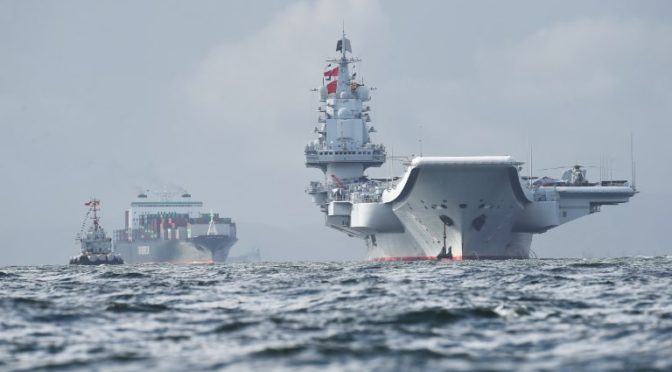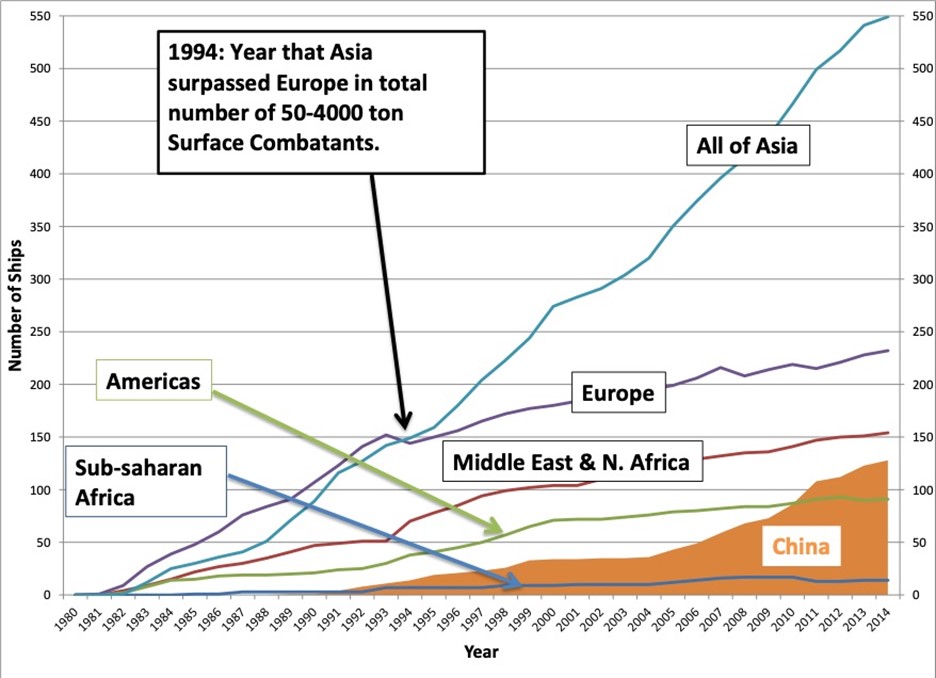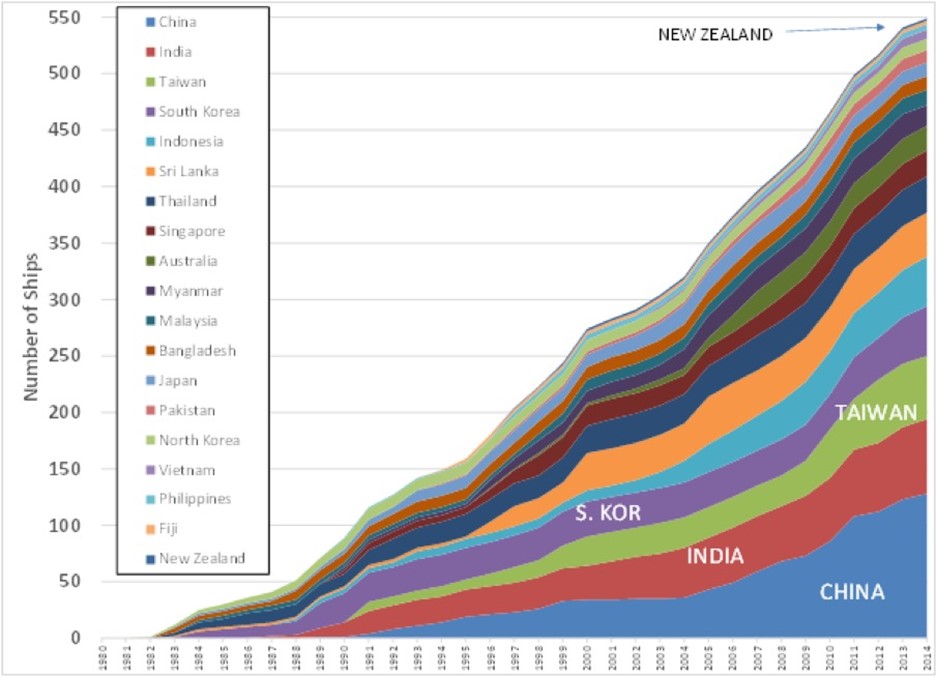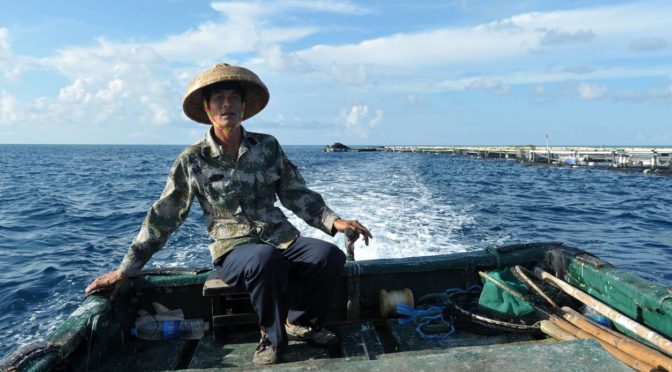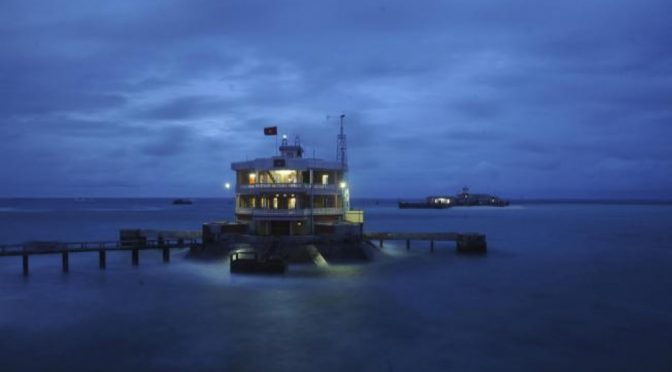By Capt. Tuan N. Pham, USN
The setting is the South China Sea (SCS) in 2035. On the Chinese island of Mischief Reef, Senior Captain Chen, the People’s Liberation Army Navy (PLAN) Spratly Islands Commander, considers a Philippines Navy request to conduct a quarterly search and rescue drill in the vicinity of the Chinese island of Scarborough Shoal. At the Philippines Navy HQ in Manila, Captain Arroyo goes over the details of the naval drill and approves its execution pending authorization from the PLAN. Near the Chinese island of San Cay in the middle of the SCS, a lone Vietnamese fishing boat evades a China’s Coast Guard (CCG) patrol craft. The fishing boat captain knows full well the penalties for illegal fishing in Chinese waters – arrest, confiscation, fine, and imprisonment. At the Petronas Corporate HQ in Kuala Lumpur, a Malaysian vice president negotiates a proposed joint development project in the vicinity of the Chinese islands of Natuna with a Chinese counterpart from China’s National Offshore Oil Corporation. Inside the Association of Southeast Asian Nations (ASEAN) Secretariat Building in Jakarta, the staff reworks next month’s meeting agenda based on guidance from Beijing.
While conjectural now, the SCS as China’s de facto home waters may become a reality in a few years. If so, the dystopian future represents a blatant contravention of the United Nations Convention on the Law of the Sea (UNCLOS) and another blow to the weakening rules-based liberal international order that has provided global prosperity and security for over 70 years. The risk is too high to defer action or do nothing on the wishful hope of Chinese benevolence. The time to act is now. It is much easier to slow or stop a large boulder rolling down a steep hill near the top than wait until it gains speed and momentum near the bottom. Inaction, or worse yet, retrenchment further reinforces the ingrained Chinese belief that it is an unstoppable rising power, and the United States is an irreversible waning power.
Beijing’s Gambit
Under the cover of the coronavirus (COVID) pandemic, China took advantage of the outbreak to expand and strengthen its administrative control and jurisdictional authority over the disputed and contested waters and intimidate regional neighbors to acquiesce to its national will. But Beijing misread the geopolitical landscape in 2020 and miscalculated its response. Chinese leaders wrongly assumed that the region and the international community would be distracted with and weakened by COVID, and that they could advance their national interests in the SCS with acceptable political and military risks and costs.
At the onset of COVID, General Secretary of the Chinese Communist Party (CCP) Xi Jinping may have thought something along these lines:
“As the regional countries, the United States, and the international community look inward to deal with the global pandemic and the force readiness of the U.S. Navy (USN) and its allies in the Pacific appears impacted by COVID, now may be an opportune time to advance China’s interests in the SCS. I anticipate a serious backlash from the world as our COVID misinformation campaign fails, so better to have something to bargain with later. I may also have to remind the people that only the CCP and PLA under my leadership can defend Chinese national interests, particularly when it comes to national unity [territorial integrity] and rejuvenation [Chinese Dream].”
Pursue Cumulative Strategy
Although the U.S.-led regional and international response temporarily checked the increased Chinese aggression in the SCS, it will not alter China’s long-term revanchist design for the international waterway or influence its revisionist global ambitions. To do that, the United States should heed Sun Tzu and pursue an enduring cumulative strategy – a series of connected actions that, when taken together, asymmetrically attacks China’s strategy, undermines China’s developing regional partnerships, and prompts China to overreact and overreach. Firstly, the United States should help the other claimants expand and strengthen their footprints in the SCS and advance resource exploration and development in collaboration with multinational corporations and other state actors. Secondly, the United States should promote and support more legal challenges to China’s excessive maritime claims and ratify UNCLOS to better pursue that avenue. Thirdly, the United States should make more investments in maritime domain awareness (MDA) and law enforcement (LE) capabilities for the other claimants and ASEAN countries bordering the SCS. Lastly, the United States should increase and enhance persistent and collective maritime presence in the SCS to include holding the next biennial Rim of the Pacific (RIMPAC) exercise in the strategic waterway.
Why Act
In the context of the SCS, Chinese overreach is any action that empowers Beijing to dictate who can occupy territories, exploit resources, and conduct commercial and military activities in the disputed and contested waters (as illustrated in the dystopian vignette), undermining the rule of law and necessitating a strong response from the United States and the international community. These overreactions include but are not limited to declaring and enforcing an air defense identification zone; requiring notification of (and perhaps permission for) transits and operations; demanding consultation with (and perhaps approval from) Beijing for any hydrocarbon exploration and development; regulating fishing throughout the SCS; policing the SCS as territorial waters; seizing and militarizing the Natuna Islands, militarizing Scarborough Shoal, and further militarizing the Paracel and Spratly Islands (strategic control points within the SCS); demilitarizing the other SCS claimants; and barring ASEAN countries from military activities outside of ASEAN.
The Chinese overreach, or overreactions, may further push the SCS claimants, other ASEAN countries (though not ASEAN as a whole), and the international community to take a more assertive stance against Beijing. The nature, scope, and extent of the pushback may buy more time for Washington to reverse the erosion of U.S. military advantages and unfavorable trends in the SCS, and for the enduring Chinese domestic problems to further weaken the fragile Chinese economy that underpins its maritime activities locally in the SCS and its coercion globally. These potential effects overlap in time, space, force, and value. From a regional perspective, a strengthened America with confident allies and partners advances a maturing Free and Open Indo-Pacific. From a global perspective, actions that uphold global rules and norms reinforce the weakening rules-based liberal international order.
What and How to Act
While some of the following proposed actions have been discussed individually before, both by myself and others, they have not been wholly framed in this targeted, synchronized, and integrated purpose and manner. They span the diplomatic, information, military, and economic (DIME) instruments of national power and are consistent with the U.S. National Defense and National Military Strategies to counter malign influence: “Compete, deter, and win below the level of armed conflict; and be strategically predictable, but operationally unpredictable, and strengthen U.S. alliances and partnerships in the Indo-Pacific.” They asymmetrically attack China’s strategy and undermine its developing partnerships in the SCS by imposing more costs (economic), winning the narratives (information), encouraging greater restraints (diplomatic), and denying the benefits or objectives thereof (military).
As Sun Tzu said: “The supreme importance in war is to attack the enemy’s strategy, next best is to disrupt his alliances, next best is to attack his army, the worst policy is to attack his cities.” It makes more strategic sense to counter Beijing by undercutting its strategy and undermining its regional relations: Operate and compete in the gray zone. Challenge China just below the threshold of armed conflict, but avoid conflict altogether. It is more advantageous and less costly to take risks and deter a conflict than to pay the price of actually fighting one.
Impose More Costs
The most effective and enduring way to dissuade and deter Beijing in the SCS is to impact its economy (pocketbook). This can be done by helping the other claimants expand and strengthen their military, basing, and infrastructure footprints and advance their resource exploration and development in the strategic waterway, thereby raising China’s operating costs in the SCS. China, Vietnam, Philippines, Malaysia, and Taiwan occupy nearly 70 disputed reefs and islets spread across the SCS. China far exceeds them in terms of reclaimed land, built infrastructures, and fielded intelligence surveillance reconnaissance (ISR) and power projection capabilities, but these local advantages come at substantial economic and political costs. To level the playing field, the U.S. should assist the other claimants to reclaim more land and improve infrastructures on their internationally recognized maritime claims. By focusing on the recognized geographic features within their exclusive economic zones (EEZ), the other claimants would steer clear of any inconsistency with the Permanent Court of Arbitration (PCA) fourth ruling that “China aggravated and extended the disputes through its dredging, artificial island-building, and construction activities.”
Another “escalate to de-escalate” strategy option is to promote more oil and gas exploration and development with multinational corporations and other state actors like Russia’s Rosneft and Gazprom, India’s Oil and Natural Gas Corporation, Japan’s Idemitsu Kosan and Teikoku Oil, and Exxon Mobil. By internationalizing and diversifying the SCS issue, Beijing could be compelled to compromise and cooperate with the other claimants for peaceful and equitable sharing of the vast oil and gas resources under the SCS. While there is no specific provision in UNCLOS requiring state-to-state cooperation to manage oil and gas resources, certain UNCLOS articles offer mechanisms to encourage compromise and cooperation in resource development. This development could be done equitably and consistently with international laws and the domestic laws of all involved claimants.
Win the Narratives
Indonesia, Malaysia, Philippines, and the other ASEAN countries are pushing back in the SCS and pressuring China on the long-stalled SCS Code of Conduct which is set to finalize this year. They were encouraged by Vietnam as the 2020 ASEAN Chair, Vietnam’s strong response to Chinese encroachments into its EEZ in 2020, Hanoi’s consideration to take Beijing to the PCA, and the release of Vietnam’s 2019 Defense White Paper. The fleeting geostrategic conditions present yet another opportunity for America to actively promote and support more legal challenges to China’s excessive maritime claims in the SCS. Hanoi, Kuala Lumpur, and the other SCS claimants could leverage the legal precedent set by the 2016 PCA ruling in favor of Manila and submit their challenges to the PCA for arbitration. Washington should encourage these legal challenges, but to be more effective, America must first ratify UNCLOS if its support is to have international legitimacy and be taken seriously by the other claimants. Washington should also encourage a multilateral “grand bargain” for the other claimants to settle their disputes with each other, and thereby providing a united front to China’s excessive maritime claims.
Encourage Greater Restraints
An integral part of the diplomatic initiatives surrounding the SCS is shared situational awareness of the destabilizing Chinese activities therein. It is in the interest of the SCS claimants and ASEAN countries at large to “maintain MDA of their national maritime boundaries as well as of the adjacent international waterways.” They would largely welcome the transparency. Transparency promotes consensus, enables individual and collective responses, mitigates Chinese information operations against them and within ASEAN itself, and strengthens deterrence against Chinese activities below the threshold of armed conflict. Persistent ISR may also give pause to Beijing if it knows that it is being monitored and that its actions are attributable. Put simply, the other claimants and ASEAN countries cannot act collectively without first knowing what, how, where, and when to act.
Another key diplomatic component to stymie Beijing’s efforts to exert increasing administrative control and jurisdictional authority over the SCS is to build up regional LE capabilities and capacities in terms of people (training), processes (tactics), and things (equipment) and prevent China from dominating the LE domain – as the recently passed CCG law might portend. The new Chinese law authorizes the CCG to demolish foreign constructions on Chinese-claimed maritime features (which implies all such Chinese-claimed maritime features within the SCS) and allows the use of weapons against foreign vessels in carrying out these sovereignty operations. The CCG also has been given the authority to board, search, detain, and expel foreign vessels, and arrest individuals suspected of violating Chinese maritime laws (which implies greater authority over international maritime laws) in the waters under Chinese jurisdiction (which means the whole SCS).
Deny the Benefits or Objectives
The U.S. should deny Beijing’s objectives in the SCS, or at least diminish the benefits of its actions therein. There is still much value in continuing to challenge China’s excessive maritime claims through a deliberate and calibrated campaign of persistent presence operations – transits and overflights, exercises, and freedom of navigation operations (FONOP). In 2019, the USN conducted nine FONOPs, an inaugural U.S.-ASEAN maritime exercise, annual Cooperation Afloat and Readiness and Training drills, and several combined and multinational naval operations. In 2020, the USN conducted 11 FONOPs, a dual-carrier strike group operation, and a trilateral maritime exercise with the Japan Maritime Self-Defense Force and Royal Australian Navy (RAN). To date in 2021, the USN has conducted two FONOPs, a dual-carrier strike group operation, an expeditionary strike group operation, and a bilateral maritime exercise with the RAN. The number of FONOPs in 2019 and 2020 is a dramatic turnaround from the previous years (2015 – two, 2016 – three, 2017 – six, 2018 – five) in terms of operational tempo – despite the COVID impact in 2020.
The U.S. Coast Guard (USCG) has also oriented itself toward China by deploying more cutters and personnel to the region to help train their coast guards. With its developing “regional partnerships and extensive experience strengthening maritime LE regimes,” the USCG is well suited and postured to address the growing need for greater maritime governance in the disputed and contested waters. The United States’ allies and partners have likewise stepped up their presence and operations in the SCS in support of freedom of navigation (FON) – most notably Japan, Australia, India, United Kingdom, and France. Failing to conduct these lawful and routine operations in the aftermath of the landmark 2016 PCA ruling sends the wrong strategic signals to Beijing. The right strategic signals moving forward are more combined and multinational operations and exercises that underscore the universal maritime right of all nations to “fly, sail, and operate wherever international law permits.”
The United States should hold the next RIMPAC exercise in the SCS. The exercise would push back against China’s unilateral militarization of the strategic waterway, reinforce the legal standing of the PCA ruling that invalidated Beijing’s excessive maritime claims, underscore the universal importance of the rule of law and compliance with global norms, and demonstrate that the United States and like-minded nations are willing to collectively stand up for their national interests and shared values. The nature and scope of the exercise could be calibrated to achieve the desired objective. That objective may only require a portion of the exercise to be held in the SCS.
Too Little or Too Much
For those who view the actions as too little, Washington has more options to dissuade and deter Beijing in the SCS: Build an enduring framework of bilateral and multilateral free trade agreements with ASEAN countries to bind the United States to the regional economies and keep them from moving more toward economic alternatives like the China-led Asian Infrastructure Investment Bank, Belt and Road Initiative, and Regional Economic Comprehensive Partnership. Lay the groundwork for a regionally-sponsored and -led independent environmental assessment detailing the impact of the damaging Chinese dredging, artificial-island building, and over-fishing to the fragile marine ecosystems. Upgrade the bilateral relationships with the Philippines, Vietnam, and Malaysia to strategic partnerships, and advance and accelerate the development of the Quadrilateral Security Framework. Lastly, draw a sharp comparison between Chinese divergent sovereignty positions on and convergent “gray zone” activities in the SCS and the Arctic Ocean to heighten the growing Russian and Nordic concerns of the latter. Then triangulate and bring Russia into the SCS fray to further internationalize and diversify the strategic waterway and asymmetrically check China’s growing Arctic ambitions. These options were not explored for brevity but should be considered in future strategy re-assessment on how best to influence and deter Beijing in the SCS.
Some view these actions as too much, fearing that the recommendations risk pushing Xi (and the CCP) over an invisible red line drawn by “fear, honor, and interest.” The key to the cumulative strategy is for Washington to retain escalation dominance, freedom of movement, and strategic initiative to impose its will on Beijing. As Sun Tzu said, “the clever combatant imposes his will on the enemy but does not allow the enemy’s will to be imposed on him.” Washington should seek to impose costs, deny benefits (objectives), encourage restraints, and win the narratives so that the only acceptable strategic calculus for Beijing is to curb or abandon its ambitious and expansive enterprise in the SCS. Like a rheostat, this diversified approach can adjust the “how” to achieve the desired “what.” The strategy must also offer off-ramps throughout the continuum of competition so that Xi (and the CCP) can spin the domestic narratives and save face with the Chinese people. The strategic objective is deterrence, not regime change. The desired end state is to negotiate terms from a position of advantage like during the U.S.-China trade war. China respects resoluteness (strength) and disrespects vacillation (weakness).
Act Now
It is clear that the status quo or retrenchment will have negative consequences for the United States, the region, and the world. It is equally clear that Washington must act now to turn the tides in the SCS and avert a dystopian future when Beijing exerts administrative control and jurisdictional authority of the strategic waterway. The outlined proposals provide a range of DIME options to prompt overreach by Beijing. Such overreaction may cause regional countries, and the greater global community, to view China’s destabilizing actions for what they truly are – a threat to the rules-based liberal international order.
Captain Tuan Pham is a maritime strategist, strategic planner, naval researcher, and China Hand with 20 years of experience in the Indo-Pacific. The views expressed here are personal and do not necessarily reflect the positions of the U.S. Government or U.S. Navy.
Feature Photo: The Philippine Coast Guard reported that despite repeated demands by Manila that Chinese ships leave Whitsun Reef, at least 240 Chinese vessels remained in the area and surrounding waters. Photo credit: Philippine Coast Guard, 16 Apr 2021.


